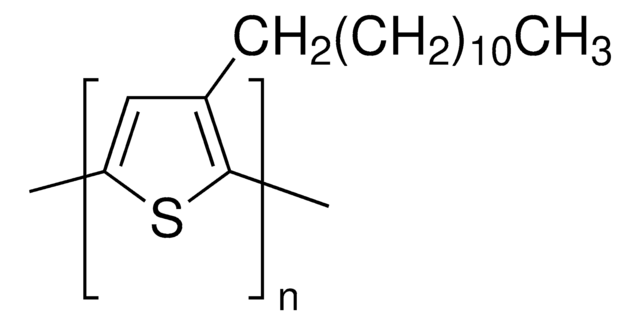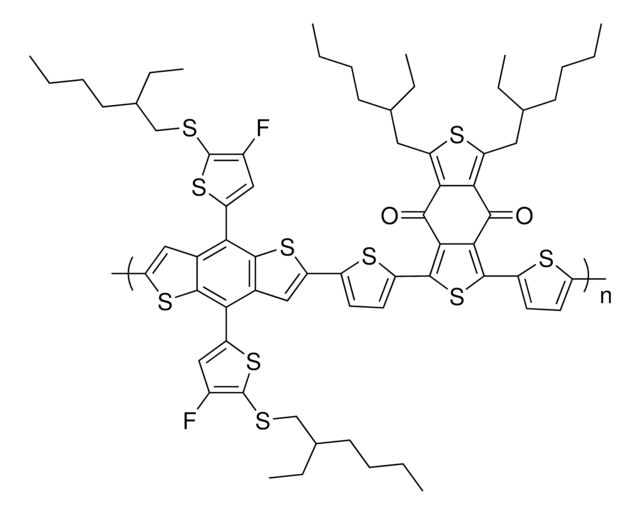745820
Difluoro{3-ethyl-5-[1-(4-ethyl-3,5-dimethyl-2H-pyrrol-2-ylidene-N)ethyl]-2,4-dimethyl-1H-pyrrolato-N}boron
98% (HPLC)
Sinónimos:
1,3,5,7,8-Pentamethyl-2,6-diethylpyrromethene-difluoroborate, 2,6-Diethyl-1,3,5,7,8-pentamethylpyrromethene-boron difluoride, 3-Ethyl-5-[1-(4-ethyl-3,5-dimethyl-2H-pyrrol-2-ylidene)ethyl]-2,4-dimethyl-1H-pyrrole, boron complex, Exciton Pyrromethene 567, P 567, Pyrromethene 567
About This Item
Productos recomendados
Ensayo
98% (HPLC)
Formulario
solid
mp
208-213 °C
fluorescencia
λex 522 nm
cadena SMILES
CC(C1=C(C)C(CC)=C(C)N1B(F)2F)=C3[N]2=C(C)C(CC)=C3C
InChI
1S/C18H25BF2N2/c1-8-15-10(3)17-12(5)18-11(4)16(9-2)14(7)23(18)19(20,21)22(17)13(15)6/h8-9H2,1-7H3
Clave InChI
DZSMVBDAUBBZJD-UHFFFAOYSA-N
Descripción general
Aplicación
Used for solid-state dye laser devices.
Palabra de señalización
Warning
Frases de peligro
Consejos de prudencia
Clasificaciones de peligro
Eye Irrit. 2 - Skin Irrit. 2 - STOT SE 3
Órganos de actuación
Respiratory system
Código de clase de almacenamiento
11 - Combustible Solids
Clase de riesgo para el agua (WGK)
WGK 3
Punto de inflamabilidad (°F)
Not applicable
Punto de inflamabilidad (°C)
Not applicable
Elija entre una de las versiones más recientes:
Certificados de análisis (COA)
¿No ve la versión correcta?
Si necesita una versión concreta, puede buscar un certificado específico por el número de lote.
¿Ya tiene este producto?
Encuentre la documentación para los productos que ha comprado recientemente en la Biblioteca de documentos.
Nuestro equipo de científicos tiene experiencia en todas las áreas de investigación: Ciencias de la vida, Ciencia de los materiales, Síntesis química, Cromatografía, Analítica y muchas otras.
Póngase en contacto con el Servicio técnico![Difluoro(4-(1,1-dimethylethyl)-2-{1-[4-(1,1-dimethylethyl)-3,5-dimethyl-2H-pyrrol-2-ylidene-N]ethyl}-3,5-dimethyl-1H-pyrrol-2-ylidene-N]ethyl}-3,5-dimethyl-1H-pyrrolato-N)boron 98% (HPLC)](/deepweb/assets/sigmaaldrich/product/structures/207/879/8046aafd-78ca-4fd8-92dc-801de0b6cc53/640/8046aafd-78ca-4fd8-92dc-801de0b6cc53.png)
![Difluoro{2-[(3,5-dimethyl-2H-pyrrol-2-ylidene-N)methyl]-3,5-dimethyl-1H-pyrrolato-N}boron 99% (HPLC)](/deepweb/assets/sigmaaldrich/product/structures/518/861/c19c64be-654e-472e-a069-30ffccb1a8cd/640/c19c64be-654e-472e-a069-30ffccb1a8cd.png)
![Difluoro{2-[1-(3,5-dimethyl-2H-pyrrol-2-ylidene-N)ethyl]-3,5-dimethyl-1H-pyrrolato-N}boron 99% (HPLC)](/deepweb/assets/sigmaaldrich/product/structures/196/394/4c2c0eae-f749-44bf-a37b-84bf0226092e/640/4c2c0eae-f749-44bf-a37b-84bf0226092e.png)







